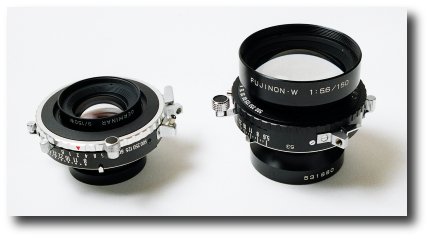
150mm Fujinon W/EBC f/5.6
150mm Docter Optic Geraminar W f/9
| Home |
| Last update: 31 January, 2006 |
Fujinon 150mm W/EBC vs 150mm Germinar W

|
|
Right to left 150mm Fujinon W/EBC f/5.6 150mm Docter Optic Geraminar W f/9 |
This is the third part of my three part nuttiness. In the first part I compared a c.1990s Nikkor 200mm M f/8 against a pair of c.1930s and c.1940s Bausch and Lomb Protar Series V f/18 lenses. That was serious nuttiness. Then I compared a c.1950s Schneider Angulon f/6.8 against a new super duper aspheric Schneider 110mm Super Symmar XL f/5.6 lens. That was fun. And for this test I pit my recently acquired Germinar W f/9 "copy" lens against a Fujinon 150mm W/EBC (NSW) f/5.6. I wanted to know, once and for all, if there was any practical difference between plasmat design lenses optimized for working distances of 20:1 and those optimized for copy work at 1:1.
The previous "tests" showed me that under real world circumstances that old uncoated optics can perform extremely well. An old Supermatic #0 mounted uncoated Bausch and Lomb (8x10) Protar series V proved this point. I learned that old coated optics can give images equal to new multi-coated lenses. A slightly more recent single coated (c.1940s) Supermatic #0 mounted Bausch and Lomb (8x10) Protar series V is just as nice as my multi-coated Nikkor 200mm M. And I learned that in those cases where lens coverage was not as important as size and weight, that old simple lens designs could return images as rich in detail and flare control as new aspheric optics. The wee-90mm Schneider Angulon f/6.8 will be carried in place of my heavier and hugely expensive Schneider 110mm Super Symmar XL when I travel overseas.
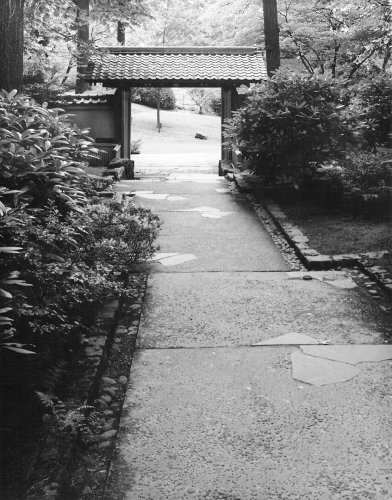
|
|
Path - Japanese Garden TMax100 film, 1/2sec, f/22 150mm Geraminar W f/9 |
As you by now know I travel sometimes on business. I prefer carrying the lightest, smallest, but largest image area photo gear I can get away with. In this case I was hoping to downsize my already small 150mm Fuji to carrying the incredibly small light Germinar W. But there was a question as to the performance of a copy lens compared against the traditional plasmat optimized at distances closer to infinity.
The Fujinon W/EBC f/5.6 is a wonderfully small, compact, sharp lens. It is in mint condition. Fuji's large format lenses are world class. Some users report that "W" series lenses cover approximately 80 degrees. This lens was advertised a being a NSW (if memory serves) when I bought it for incredibly cheap. I recall seeing a cross section diagram of this particular series of Fuji lenses. Most Fuji's in this focal length are the common 6 element 4 group plasmat design. But for some reason, my lens might be a 6 element 6 group all airspace design (or was that 8 elements in 8 group?). I have no idea if this is indeed the case. And if it is, I have no idea what design this lens is based on. All I know is that this lens is very sharp. It takes a 52mm filter (the same as the Nikkor 200mm M f/8 and a wide range of other small, compact LF lenses) and is mounted in a black ring Copal #0. I haven't weighed this lens, but it feels like it weighs around 225grams. I enjoy Fuji lenses more than just about any LF optic. I don't know why, but these just tickle my itch in ways that other lenses barely warm up to. There's not a Fuji LF lens that I haven't liked.
The Germinar W 150mm f/9 lens is something of an oddity. To start, it is exceedingly rare. Further, it is probably the smallest lightest 150mm lens a person can find in a shutter. Mine is mounted in a Seiko #0 shutter and weighs 135grams. Interestingly, the optic is multi-coated. This is something that I wished Schneider's GClaron line of optics had. The lens is a 6 element 4 group plasmat "copy" lens that is optimized for work at distances of 1:1. The lens is probably very difficult to find on the open market as very few were made prior to the company being aquired by Rodenstock/Hella. My hope is that the results of this test would mirror a similar test using a Schneider GClaron in place of the Germinar W. I enjoy and use several GClaron lenses and feel their performance is quite fine. For this test, it was interesting to me that the wee-Germinar would be multi-coated, so I choose it over a 150mm GClaron.
Fuji large format lenses have evolved over time. Back in the early 1970's, the first of the "W" series was introduced. They were single coated lenses and can be identified by the front barrel lens information being found on the inside of the filter ring. At some point Fuji transitioned the "W" series to include their EBC (electron beam coating) multi-coating process. At that point the lens information was engraved around the exterior of the front barrel. To the best of my knowledge, these "W" lenses are all 6 element 4 group plasmats. My lens may be of a slightly different design, but from the exterior I can tell no difference between it and the traditional design lenses. Later, Fuji redesigned and renomenclated their "W" series into "CMW". A wide range of these lenses carry a huge 62mm filter size, regardless of the size of the front element group. This means for the formerly tiny 125mm "W", the front of the "CMW" lens is quite large. I am unaware of any advantage to the "CMW" optics over "W" lenses as far as resolution and contrast are concerned. In any event, Fuji still makes "CMW", "A" (copy lenses), "C" (compact lenses), and other lens lines for large format work.
A little perspective -
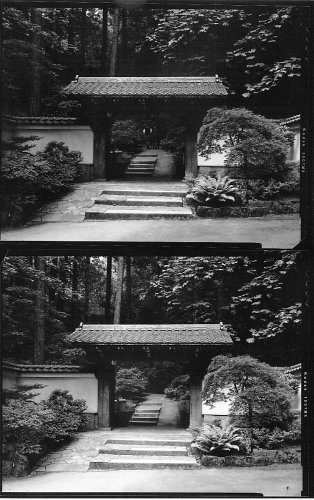
|
|
Unmanipulated contact sheet Both exposures on TMax100 film, 1/2sec, f/22
150mm Fujinon W/EBC f/5.6 (top) |
First up, a Fujinon 150mm Angulon f/5.6 mounted in a Copal number zero shutter. The lens is multi-coated coated, small, and light (at around 225 grams). The Fuji gives approximately 72 degrees of coverage. Some users report that the lense is capable of giving a nice 80 degrees of coverage. In any event, there is plenty of coverage for rise/fall and swing/tilt on 4x5. If the Germinar W hadn't come along, I would have willingly added this lens to my super light weight travel kit.
Next up, a very rare Docter Optic Germinar W f/9 lens. This lens was purchased new in 2005 and came packed in the new factory fresh plastic sealed wrapper, and was mounted in a barrel. It is multi-coated and is an optical work of very small light art. I remounted the original barrel lenses into a Seiko #0 shutter. This shutter is itself very light and compact. So the overall lens is much lighter than the 150mm Fujinon ~225 grams by weighing a mere 135grams.
The test setup
To perform a mostly meaningful test, I needed to follow a common process and practice for both lenses. In this case I chose the following camera equipment, film, chemicals, and inspection processes.
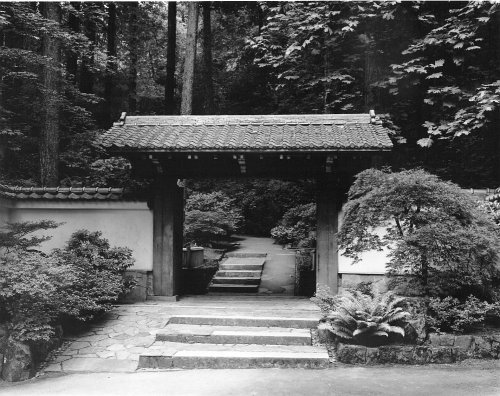
|
|
Lower Gate - Japanese Garden 8x10 inch print TMax100 film, 1/2sec, f/22 150mm Fujinon W/EBC f/6.8 |
On a recent trip to the Japanese Gardens I stalled at the lower gate. This is where I tested the 183mm Bausch and Lomb Series V Protar f/18 lenses against a modern Nikon 200mm M-series f/8. As you by now know, the 1896 patent year lenses held up quite remarkably against the Japanese lens. For the test of the 150mm lenses I kept the tripod in same position as the Protar/Nikkor test, and simply mounted the 150mm lenses in sequence. As in the case of the tests of the ancient optics, I chose to focus on the roof edge tile detail.
I framed the scene using the 150mm Fujinon first. Exposed one sheet of film. Then mounted the 150mm Germinar W, focused, and exposed the next sheet of film. I observed that there was little to no visible difference in ground glass brightness between the f/5.6 Fujinon and the f/9 Germinar. Even in dimly lit heavy overcast light pointed into deep shadows, both lenses focused quickly and accurately.
Test results -
Inspecting the proof sheet showed nice even exposure for both lenses. The scene was lit by dark overcast skies and was contrasty. The plants beyond the gate were very dark (around Zone 2). There appeared to be no difference between the lenses for how they handled contast. As I would expect from multi-coated optics, both handled contrast in an excellent manner. The negatives would be easy to print from. As contact images there was no way that I could not tell any differences in resolution between the lenses. Both images were nice and sharp.
Using either my 2.25 magnification reading glasses or the 10x loupe to inspect the proof sheets yielded nothing more than my straight visual inspection had. Both lenses showed equal resolution. Since I would be enlarging 4x5 negatives, the proof sheets gave little additional information beyond confirming that the shutters worked well and contrast was nicely controlled in both cases.
Visual inspection of 8x10 enlargement images -
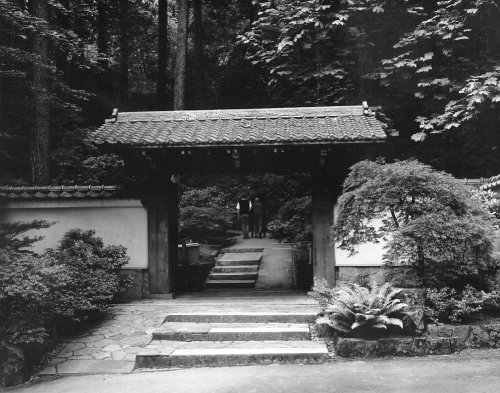
|
|
Lower Gate - Japanese Garden 8x10 inch print TMax100 film, 1/2sec, f/22 150mm Docter Optic Germinar W f/9 |
Print inspection from the two lenses yielded images of equal value in the shadows and highlights. There was no noticable difference between them at first look.
There were no image resolution differences between the images. I confirmed this first visually, then when using the 2.25x magnification reading glasses, and lastly when viewing the prints with a 10x loupe. I was very pleased with the results thus far. I confirmed that my wee-Germinar W could produce as pleasing an image as the very fine Fujinon. I have taken to enlarging my "better" images to 11x14 and larger. So the next test would be important to me in deciding if I could carry the Germinar when I travel.
16x20 section enlarged prints
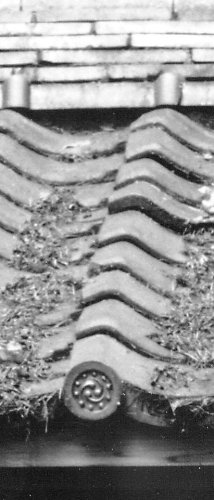
|
|
Tile detail- Japanese Garden Section taken from 16x20inch enlargement TMax100 film, 1/2sec, f/22 150mm Fujinon W/EBC f/5.6 |
Enlarger grain focusing negative inspection
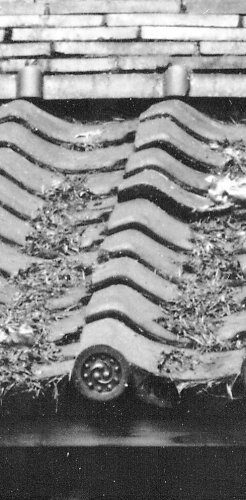
|
|
Tile detail- Japanese Garden Section taken from 16x20inch enlargement TMax100 film, 1/2sec, f/22 150mm Docter Optic Germinar W f/9 |
Conclusions - I undertook this test to see if the 150mm Docter Optic Germinar W f/9 copy lens would be a suitable replacement for my very nice 150mm Fujinon W/EBC f/5.6. I continue to look for very small light weight lenses that can be carried on business trips. I had some doubts about the 150mm Germinar's abilities due to my lack of experience with this rare optic. First, there was a question in my mind about how a copy lens would behave under typical photographic conditions. Afterall, why would a lens manufacturer offer lenses optimized at 1:1 and others optimized at, say 10:1? Second, Docter Optic is no longer in business. So if I liked this lens, how could it be recommended to others?
For all these nutty tests I limited myself to working in Black and White. B&W is my chosen medium. So there is no accounting for how the various lenses might behave when shooting color film. From these tests I have no idea how color images would compare between lens. But I could predict that color images from any optic would be pleasing. The 150mm images I reviewed here were extremely sharp, which leads me to believe that both lenses do a good job at color focus control.
After inspecting the test negatives at 160x I am beginning to see where both lenses are operating at f/22 diffraction limits (just over 60 lines per millimeter). This is an important finding. For this test I deliberately considered the performance of a copy lens due to the extremely small size and very light weight. This leads me to (perhaps again?) confirm that plasmat copy lenses are quite capable and may be used as small light replacements for sometimes heavier "general purpose" plasmats that are optimized for distances closer to infinity.
The 150mm Docter Optic Germinar W f/9 multi-coated lens was an incredible performer. It handles contrast as well as the 150mm "general purpose" multi-coated Fujinon. Subtle details are retained and expressed by both lenses. For B&W work, there is no way to tell the difference between them.
A 4x5 photographer who found a 150mm Germinar W might be a very lucky person indeed. The lens is very sharp and contrasty. However, if a photographer were simply looking for a traditional widely availble general purpose 150mm optic, they need look no further than the Fujinon W/EBC. I have seen these sell on eBay for around $200US. These are remarkably under-priced for the level of performance Fuji lenses return.
The Germinar W is tiny (weighs around 135 grams), is mounted in a working shutter, and is very sharp. I will be carrying it along side two other lenses, a 90mm Angulon f/6.8 (weighing 130 grams) and a Nikkor 200mm M f/8 (weighing 220 grams). This lens trio will be carryed with an Ikeda Anba 4x5 camera. The whole 4x5 kit weighs less than a Mamiya 7 camera with two lenses.
I am left wondering how photographers will ever see differences in image quality between "copy" lenses and "general purpose" lenses in typical field work.
Email if interested in providing comments or feedback: Christopher Perez